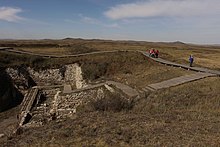
Back Shangdu Afrikaans Shangdu (Yuan-Dynastie) ALS زانادو Arabic زانادو ARZ Xanadú AST Шанду Bulgarian Xanadú Catalan Šang-tu Czech Шанду CV Shangdu (Yuan-Dynastie) German
This article contains too many or overly lengthy quotations. (September 2024) |
| UNESCO World Heritage Site | |
|---|---|
 Ruins of Shangdu | |
| Location | Shangdu Town, Zhenglan Banner, Inner Mongolia, China |
| Criteria | Cultural: ii, iii, iv, vi |
| Reference | 1389 |
| Inscription | 2012 (36th Session) |
| Area | 25,131.27 ha |
| Buffer zone | 150,721.96 ha |
| Coordinates | 42°21′35″N 116°10′45″E / 42.35972°N 116.17917°E |
| Shangdu | |||||||||||
|---|---|---|---|---|---|---|---|---|---|---|---|
| Chinese | 上都 | ||||||||||
| Hanyu Pinyin | Shàngdū | ||||||||||
| Literal meaning | Upper Capital | ||||||||||
| |||||||||||


Shangdu (Chinese: 上都; pinyin: Shàngdū; pronounced [ʂâŋtú]; lit. 'Upper Capital'; Mongolian: ᠱᠠᠩᠳᠤ, Mongolian Cyrillic: Шанду, romanized: Šandu), popularly known in English as Xanadu (/ˈzænəduː/ ZAN-ə-doo), was the summer capital[1][2] of the Mongol-led Yuan dynasty before Kublai moved his throne to the former Jin dynasty capital of Zhōngdū (Chinese: 中都; lit. 'Middle Capital') which was renamed Khanbaliq (present-day Beijing). Shangdu is located in the present-day Zhenglan Banner, Inner Mongolia. In June 2012, under its English name Xanadu, it was made a World Heritage Site for its historical importance and for the unique blending of Mongolian and Chinese culture.[3]
Venetian traveller Marco Polo described Shangdu to Europeans after visiting it in 1275. It was conquered in 1369 by the Ming army under Chang Yuchun. Historical accounts of the city inspired the poem Kubla Khan, written by English Romantic poet Samuel Taylor Coleridge in 1797, who called it “Xanadu”.
- ^ Tomoko, Masuya (2013). "Seasonal capitals with permanent buildings in the Mongol empire". In Durand-Guédy, David (ed.). Turko-Mongol Rulers, Cities and City Life. Leiden: Brill. p. 239.
- ^ Atwood, Christopher P. (2004). Encyclopedia of Mongolia and the Mongol Empire. Facts on File. p. 605.
- ^ "Xanadu (China), Bassari Country (Senegal) and Grand Bassam (Côte d'Ivoire) added to UNESCO's World Heritage List". Archived from the original on April 15, 2016.

